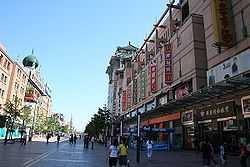Wangfujing
Coordinates: 39°54′40.16″N 116°24′18.99″E / 39.9111556°N 116.4052750°E

Wángfǔjǐng (Chinese: 王府井; pinyin: Wángfǔjǐng; literally "Prince's Mansion well"), located in Dongcheng District, Beijing, and is one of the Chinese capital's most famous shopping streets. The majority of the main shopping area is pedestrianised and is very popular for shopping for both tourists and residents of the capital. Since the middle of the Ming Dynasty there have been commercial activities in this place. In the Qing Dynasty, ten aristocratic estates and princess residence were built here, soon after when a well full of sweet water was discovered, thereby giving the street its name "Wang Fu" (princely residence), "Jing" (well).
Location
It starts from Wangfujing Nankou ("south entrance"), where the Oriental Plaza and the Beijing Hotel are located and the Wangfujing Subway Station north exits. The street then heads north, passing the Wangfujing Xinhua Bookstore, the Beijing Department Store as well as the Beijing Foreign Languages Bookstore before ending at the Xin Dong An Plaza and Wangfujing Catholic Church.
History

The street was also previously known as Morrison Street in English, after the Australian journalist George Ernest Morrison. Wangfujing is also one of the traditional downtown areas of Beijing, along with Liulichang.
Until the late 1990s, the street was open to traffic. Modifications in 1999 and 2000 made much of Wangfujing Street pedestrian only (aside from the tour trolley). Now through traffic detours to the east of the street.
Stores
Wangfujing is now home to around 280 famous Beijing brands, such as Shengxifu hat store, Tongshenghe shoe shop, and the Wuyutai tea house. A photo studio which took formal photos of the first Chinese leadership, the New China Woman and Children Department Store helped established by Soong Ching-ling (Madame Sun Yat-sen) are also located on the street.

Food and snacks
The Wangfujing Snack Street, located in hutongs just west of the main street, is densely packed with restaurants and street food stalls. The food stalls serves a wide variety of common and exotic street food. More common fare such as Chuanr (meat kebabs, commonly made of lamb) and desserts, such as Tang hu lu or candied fruits on a stick, are among the most popular.
Further north and perpendicular to Wangfujing is Donghuamen Street, which has a night food market of its own.
Transport
Local transit
The Wangfujing Station of Beijing Subway Line 1 is located at the intersection of Wangfujing Street and Chang'an Avenue. Bus and trolleybus routes 103, 104, 201, 211, 420 and 特11 stop at New Oriental Market (新东安市场) east of Wangfujing Street and at Wangfujing Intersection North (王府井路口北), near the southern end of the street. Bus routes 10, 41, 59, 90, 99, 104, 120, 126, 203, 205 and 420 stop at Wangfujing on Chang'an Avenue.
Gallery
<gallery caption= height="150px" perrow="6"> File:Wangfujing Dajie, Beijing.JPG|Wangfujing pedestrian street Image:Baihuodalou.jpg|The Wangfujing Beijing Department Store File:Central Beijing3.jpg|[Beijing apm|Dong'an Market/Beijing apm]] Image:Wangfujingpic4.jpg|Wangfujing snack street File:Scorpions on Wangfujing Dajie snack street in Beijing.jpg|fried scorpions File:Wangfujing Church.jpg|St. Joseph's Church also known as the Wangfujing Cathedral </gallery>
See also
- Beijing central business district
- List of leading shopping streets and districts by city
- Donghuamen Night Market
External links
| Wikimedia Commons has media related to Wangfujing. |
- Old brands of Beijing (Chinese)
- Wangfujing Website